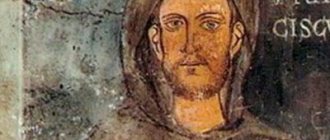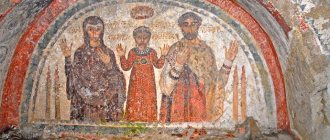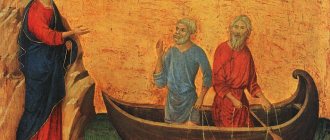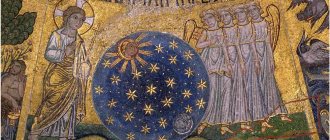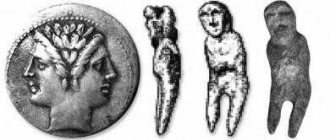Memorial Day: June 15(28)
Little is known about the first years of the life of Blessed Hieronymus of Stridon. Time has covered in oblivion the exact date of his birth, and even his worldly name (however, there is reason to think that his name was Eusebius). Jerome's birthplace is Stridon (a small town located near the borders of two regions: Dalmatia and Pannonia). Jerome's parents were Christians. There is a version that, according to their social status, they belonged to the ranks of wealthy freedmen.
Jerome received his initial education under the guidance of a teacher at home. Then, at the behest of his parents, he went to Rome, where he continued his studies. Among other educational disciplines, he studied philosophy and eloquence. During his stay in Rome, he experienced many temptations, which he did not always overcome. With all this, he managed to preserve that spark of faith that his mother and father lit in his heart as a child. On Sundays, for example, he loved to visit the tombs of Christian martyrs, the impression from which touched his soul so much that, according to his personal admission, it seemed to him as if he himself, alive, was going to the grave.
While in Rome, Jerome decided to change his life. Presumably, during this period he was baptized. Upon leaving the eternal city, while traveling through Gaul, he seriously thought about monasticism. Returning to his native Stridon in 372, Jerome no longer found his parents alive. The need to take care of his sister and younger brother, as well as his parents' inheritance, forced him to postpone his plans to become a hermit. For some time he lived in Aquileia, communicating with his comrades in the “semi-monastic” circle. Then he took a trip to the East, intending to visit Jerusalem, Syria and Egypt. However, upon reaching Antioch, he fell seriously ill.
After recovery, he settled in the Syrian Thebaid; believed to be in a local monastery. He lived there, in labors and prayer, for about five years. At the same time, he studied the Holy Scriptures and the Hebrew language. In Antioch he joined the community of Bishop Paulinus and was ordained a priest. After a short time, he moved to Constantinople, where he had communication with two great saints: Gregory of Nazianzus and Gregory of Nyssa. Leaving Constantinople in 381, he headed to Rome. At this time, a Council was held there, organized on the occasion of the Meletian schism. In Rome, the blessed father was awarded the position of secretary under Pope Damasus.
Not everyone accepted the highly spiritual life of Father Jerome: for many he served as a reproof. They began to intrigue against the saint. Slanders rained down. To all other accusations was added the accusation of sympathy for Origen.
With the death of Pope Damasus, which followed in 384, the pressure on Father Jerome only intensified: the new pope, Siricius, did not like him. Then the blessed one, taking his brother Paulinian with him, left Rome and went to the Holy Land. Having honored the holy places, he undertook a pilgrimage to Egypt. Here he was lucky enough to listen to Didymus the Blind and talk with Nitrian hermits.
In 386, Jerome headed the monastic monastery in Bethlehem. In addition to running the monastery and ascetic exercises, he was engaged in literary creativity.
The contribution of Blessed Jerome to church writing is difficult to overestimate. He left behind an extensive literary heritage. One of his most important achievements is the translation of the Books of Holy Scripture into Latin. On September 30, 420, the saint departed to the Lord.
Hieronymus of Stridonsky - patron saint of translators around the world
The article was prepared by the Prima Vista bureau, notarized translations in Moscow
Jerome received a classical education, his teacher was the grammarian Aelius Donatus. At the age of eighteen he was baptized by Pope Liberius in Rome. He was well-read, and was especially well acquainted with pagan poets and writers, but his main hobby at that time was the literature of Christianity.
Jerome traveled widely throughout the Roman Empire. Until 379, Saint Jerome led an ascetic life, settling in the desert southwest of Antioch. That year he was appointed priest of Antioch.
Soon Jerome returns to Rome, where he becomes the secretary of Pope Damasius I, who invited him to revise the translations of the gospels and psalms.
When Damasius dies in 384, Jerome has no choice but to leave Rome, since he has made enemies for himself with his open and sometimes harsh criticism of Roman society. As a result of long wanderings, in 386 he comes to Bethlehem. Jerome settled in a monastery, where he devoted many years to translating the Old and New Testaments into Latin. Eleven centuries later, the Council of Trent would recognize its translation as the official version of the Bible and call it the Vulgate.
In 410, during the conquest of Rome by the barbarian Alaric, Jerome of Stridon suspended his studies in order to provide assistance and support to numerous refugees and everyone who suffered during the hostilities. At the same time, he wrote: “I put aside my study to help them. Now we must translate the words of Scripture into actions, and instead of speaking holy words, we must do them.”
Jerome of Stridon died in Bethlehem on September 30, 420 from a long illness. His tomb is located in Rome in the Church of Santa Maria Maggiore.
The works of Jerome of Stridon can be divided into five parts: analysis of the Bible, theological discussions, historical essays, letters and, of course, translations.
His early translation works (379-81) include Origen's sermons on Jeremiah, Ezekiel, Isaiah, and the Chronicle of Eusebius of Caesarea. However, Jerome secured his place in history mainly through his translations and revisions of Bible translations. He initially believed that the Septuagint (a translation of the Holy Scriptures from Hebrew into Greek, completed several centuries BC) was the result of divine inspiration. But his long study of Hebrew and interactions with rabbis convinced him that only the original text was inspired by God. This led him to decide to undertake a new translation of the Old Testament.
His translation was mainly based on the Hebrew texts in use at the time. The Septuagint was translated from an older Hebrew version and presumably more accurate. Modern critics consider this lack of attention to ancient texts to be a serious omission, especially considering the generally observed skill of the translation work of Hieronymus of Stridon.
Jerome's gentleness with regard to his own translations set a good example for the translators who became his followers. He openly admitted his ignorance, and even expressed embarrassment, as he checked and revised some of his translations, making corrections and adding additions. But, on the other hand, he also argued that the accuracy of the translation largely depends on the reliability of the source text: often scribes unintentionally make mistakes that remain and remain in the text for centuries.
Even saints make mistakes
Now interpreters and translators all over the world celebrate September 30 as their professional holiday, since it is the patron saint day of librarians, biblical scholars, students and, of course, all translators.
Although the translation of St. Jerome was canonized by the Catholic Church, it is not an ideal work.
Jerome once stated: “I am not so foolish as to believe that any of the Lord’s words needed correction or that they were not inspired by God, but the Latin manuscripts of the Holy Scriptures obviously contain errors, as shown by the differences found in them.” . Jerome himself admitted that he had made some mistakes.
He probably made his most famous translation mistake when he gave Moses horns. The original Hebrew scripture (Exodus 34) says that when Moses came down from Mount Sinai, “rays of light” came out from his head. The Hebrew word in that passage can also mean “horns,” and Jerome chose this meaning. This mistake has been perpetuated several times. When Michelangelo created the marble sculpture of Moses in 1515, he relied on Jerome's Latin translation, the Vulgate. As a result, in Rome (in the church of San Pietro in Vincoli) to this day there is a 235-centimeter statue of Moses with horns...
Based on materials from the website www.tihof.org.
Other materials
Africa: the cradle of languages? It is generally accepted that the human proto-language, which initially had a rather simple structure, subsequently... Read more Translation and censorship in Europe Viewing translation in the light of censorship means examining the mechanisms of manipulation used since... Read more Revel. They say the translator's tongue was cut out It was not easy for translators of the late Middle Ages. Sometimes a mistake threatened them with brutal punishment. In 1404 in… Read more
Veneration of the Saint
The Catholic world deeply reveres the saint as the creator and interpreter of the generally accepted text of Holy Scripture. He is glorified as a theologian, ascetic, and Christian writer. The lives were written in the 6th-9th centuries. In 1298, the pope designated the saint among the main Teachers of the church.
Saint Birgitta called Jerome a model for any Catholic priest, emphasized support and guardianship towards the nuns, and his role in the creation and care of convents. Catholics consider September 30 as their day of remembrance.
The Orthodox Church glorifies Jerome among the blessed. According to some sources, the saint was a Slav by origin. He spent a significant part of his life in the East. Hot temper, passion, excessive pride - this is how Jerome remained in the memory of those who knew him closely. He did not achieve a reputation for holiness according to Orthodox canons. Blessed Remembrance Day - June 28. Translators consider the saint their heavenly patron; the day of memory of Jerome (September 30) is recognized as International Translator's Day.
Iconography
On icons the saint is depicted as an old man, often in a red cardinal's robe, although such a rank did not exist during Jerome's lifetime. This emphasizes the great role of the learned theologian and closeness to the pope. Other symbols characteristic of icons of the saint:
- A repentant sinner in simple clothes. Jerome beats himself in the chest with a stone and is depicted in the desert or cell.
- Model of the church, scrolls of prayers. The significance of the saint as a teacher and translator is glorified.
- A lion. According to legend, a lion with a damaged paw came to a monk in the desert. Jerome removed the thorn; the formidable predator became attached to the saint, followed him and served. Icons with a lion and the removal of a splinter emphasize the role of the saint in eradicating heresies and taming the obstinate.
- In the group of other saints are Augustine, Ambrose, Gregory the Great.
- A dying elder during his last communion.
Great artists glorified the saint in immortal paintings. Jerome was written by Lucas Cranach, Albrecht Durer, Spada, El Greco, Leonardo. The image of a saint and a man of great learning attracted the attention of many talented people.
“Not knowing the Bible is not knowing Christ” - this is what the great learned theologian Jerome believed. The saint made the Holy Scriptures understandable and close to the Western world, translated the great text, putting into his work deep faith in the Lord, spiritual efforts and knowledge. The saint tried to convey the meaning inherent in Scripture, to translate the essence, not the words, which is why his works are highly appreciated by the church and ordinary Christians.
Gallery[ | ]
- Saint Jerome. Leonardo da Vinci
- Saint Jerome in his cell. Painting by Cranach the Elder
- Saint Jerome, immersed in reading. Domenico Ghirlandaio
- Saint Jerome in his cell. Antonello da Messina
- Saint Jerome reads in nature. Giovanni Bellini
- Saint Jerome. Rubens
- Saint Jerome in his cell. 1513-1514 Durer
- Saint Jerome. Torrigiano. Seville Museum of Fine Arts
- Saint Jerome. Anthony Van Dyck, 1st third of the 17th century, collection of Heinz Kisters
- Saint Jerome. Martinez Montanez
Literature[ | ]
in Russian
- Diesperov A.
Blessed Jerome and his age. - M., 1916. - 195 p.; reprint: - M.: Kanon+ 2002, with an appendix of “Selected Letters” of Jerome, comp. and comm. A. A. Stolyarova. - Polyansky E. Ya.
Creations of the blessed. Jerome as a source for biblical archaeology. - Kazan, 1908. LXXII. — 583 p. - Jerome / N. V. Shaburov // New philosophical encyclopedia: in 4 volumes / prev. scientific-ed. Council V. S. Stepin. — 2nd ed., rev. and additional - M.: Mysl, 2010. - 2816 p.
- The Life of Blessed Jerome // Lives of the Saints in Russian, set out according to the guidance of the Chetyih-Mineas of St. Demetrius of Rostov: 12 books, 2 books. add. - M.: Moscow. Synod. typ., 1903-1916. — T. X: June, Day 15. — P. 361.
in other languages
- Antin P.
Jérôme antique et chrétien // Revue d'études augustiniennes et patristiques. - 1970. - Vol. 16. - P. 35-46. - Saltet L. (French) Russian. St. Jerome // Catholic Encyclopedia. 1913. Vol. 8 (English)
Literature
Calculated in detail in Zoeckler, “Hieronymus. Sein Leben und Wirken aus seinen Schriften dargestelt" (Gotha, 1865). Particularly noteworthy are:
- "Vita Hieronymi" - article by Vallarsi, in volume XI of his edition of the works of Hieronymus;
- Collombet, “Histoire de S. Jérôme” (P., 1844);
- Luckbeck, “Hieronymus quos noverit scriptores et ex quibus hauriens scripsit” (Lpc., 1872);
- Amédée Thierry, "S. Jerome. La société chrétienne à Rome et l'émigration romaine en Terre Sainte" (P., 1867; translation of several chapters from this work in "Proceedings of the Kyiv Theological Academy", 1868 and 1869);
- A Smirnov, “Jerome as a historian and polemicist” (“Orthodox Review” 1871);
- Shchegolev, “Life of St. Jerome" (with the Kiev translation of his works, Kyiv, 1863);
- “Life is bliss. Jerome" (in "Christian Reading" 1847);
- Filaret, Archbishop of Chernigov, in “Historical. teachings about the fathers of the church" (St. Petersburg, 1859, vol. II):
- Möhler - about the dispute between Jerome and Rufinus, in “Gesammelte Schriften und Aufsätze” (Regensb., 1839).
Notes[ | ]
- James Killian.
Truth of Our Faith. - iUniverse, 2011. - P. 193. - ISBN 1450293204. - Daniele Pevarello.
The Sentences of Sextus and the Origins of Christian Ascetiscism. - Mohr Siebeck, 2013. - ISBN 3161525795. - Le langage secret de la Renaissance: le symbolisme caché de l'art italien / Richard Stemp. - National geographic France, 2012. - P. 109. - 224 p. — ISBN 9782822900003.
- Booth AD
The Date of Jerome's Birth // Phoenix. - 1979. - Vol. 33, No. 4. - P. 346-353. - Antin, 1970, p. 35.
- Bible and painting. St. Jerome
- D. G. Dobykin
. Lectures on introduction to the Holy Scriptures of the Old Testament. - St. Petersburg: St. Petersburg Orthodox Theological Academy, 2012. - P. 66] - und Occidentalisches Sprachmeister: Welcher nicht allein hundert Alphabete nebst ihrer Ausprache, so bey denen meisten Europaeisch-Asiatische-Africanisch- und Americanischen Völckern und Nationen gebraeuchlich sind… Leipzig, 1748″
Prayers
Troparion, tone 3
You have a great representative, O God-Wise One,/ the Orthodox congregation,/ like you are an interlocutor with the venerables,/ and a participant in Divine wisdom,/ so, most wonderfully Jerome,/ pray to Christ God // grant us great mercy.
Kontakion, tone 8
(Similar to: Mounted Voivode:)
In the venerables of the most venerable / and in the blessed of the most blessed teacher, / with songs we praise the most praiseworthy Jerome, / a faithful mentor and protector, / calling to him love // Rejoice, O What about God the Wise?
Translations[ | ]
Works of Jerome of Stridon:
- Texts on Wikisource
- Media files on Wikimedia Commons
Russian translations:
- Works of Blessed Jerome of Stridon
.
(Library of the works of the Holy Fathers and Teachers of the Western Church). - Kyiv, 1879-1903; 2nd ed., not completed: - Kyiv, 1893-1915. ( The part number is indicated according to Jerome’s edition, the book number is indicated according to the general series “Library of Creations...”
) - Jerome of Stridonsky collected works 19 volumes Part 1. (Book 3.) Letters. 2nd ed. 1893.CLXXX. — 226 p.
- Part 2. (Book 4.) Letters. 2nd ed. 1894. - 480 p.
- Part 3. (Book 5.) Letters. 1880. - 410 p. (150 letters in total, 124 of them from Jerome himself)
- Part 4. (Book 6.) Life of Paul the Hermit. Life of St. Hilarion. The life of the captive monk Malchus. Preface... to the translation of the rules of St. Pachomia. Conversation against the Luciferians. About the ever-virginity of Bl. Maria. Two books against Jovinian. Book against Vigilance. Book against John of Jerusalem. 1880. - 365 p.
- Part 5. (Book 8.) Apology against the books of Rufinus. Conversation against the Pelagians... A book about famous men... Exposition of the Chronicle of Eusebius Pamphilus. Chronicle of the blessed Jerome [partial translation]. Translation of Didymus's book on the Holy Spirit. 1879. - 481 pp.; 2nd ed. 1910. - 443 p.
- Part 6. (Book 11.) Commentary on the book of Ecclesiastes... Translation of two conversations of Origen on the book of Song of Songs. Six books of commentaries on the prophet Jeremiah. 1880. - 529 p.
- Part 7. (Book 13.) Interpretations on the prophet Isaiah. Book 1-8. 1882. - 257 p.
- Part 8. (Book 15.) Interpretations on the prophet Isaiah. Book 9-14. 1882. - 321 p.
- Part 9. (Book 16.) Interpretations on the prophet Isaiah. Book 15-18. 1883. - 261 pp.; 2nd ed. 1910. - 245 p.
- Part 10. (Book 17.) Interpretations on the prophet Ezekiel. Book 1-8. 1886. - 401 pp.; 2nd ed. 1912. - 383 p.
- Part 11. (Book 19.) Interpretations on the prophet Ezekiel. Book 9-14. 1889. - 361 pp.; 2nd ed. 1912. - 336 p.
- Part 12. (Book 21.) Interpretations of the prophets: Daniel, Hosea, Joel. 1894. - 415 p. 2nd ed. 1913. - 395 p.
- Part 13. (Book 23.) Interpretations on the prophets: Amos, Obadiah, Jonah, Nahum. 1896. - 320 pp.; 2nd ed. 1913. - 307 p.
- Part 14. (Book 24.) Interpretations on the prophets Micah, Habakkuk, Zephaniah and Haggai. 1898. - 360 pp.; 2nd ed. 1915. - 351 p.
- Part 15. (Book 25.) Interpretations on the prophets Zechariah and Malachi. 1900. - 252 pp.; 2nd ed. 1915. - 255 p.
- Part 16. (Book 26.) Four books of commentaries on the Gospel of Matthew. 1903. - 390 p. (reprint: M., Nauka. [1998].)
- Part 17. (Book 27.) Commentaries on the Apostle Paul to the Galatians and Ephesians. 1903. - 391 p.
.
About the names of places found in the Holy Scriptures. Blessed Jerome, Presbyter of Stridon
. On the position and name of Jewish localities. / Per. I. Pomyalovsky. (“Orthodox Palestinian collection.” T. 13. Issue 1.). - St. Petersburg, 1894. - 547 p.
New Russian translations
:
- Jerome
. About preserving virginity. / Per. V. S. Durova. - SPb.: RKhGI. 1997. - Jerome
. Letters 1. 57, 125. About famous men (excerpts). / Per. O. E. Nesterova, I. P. Strelnikova. // Monuments of medieval Latin literature of the IV-VII centuries. — M.: Heritage. 1998. - pp. 97-146. - Hieronymus of Stridon
. A book about famous men. / Per. and comm. M. F. Vysokogo. // Church historians of the IV-V centuries. - M.: Rosspen, 2007. - P. 11-57 and comm. us. 299-372. ISBN 978-5-8243-0834-1 - Hieronymus of Stridon
. Jewish Questions on the Book of Genesis. / Per. S. Zhukova. - M.: Father's House, 2009. - 272 p. (Book series “Biblical Exegesis”)
Other translations:
- As part of the “Loeb classical library” series, one volume of Jerome (no. 262) was published: “Selected Letters”.
- As part of the “Collection Budé” series there is only correspondence in 8 volumes, 154 letters: ( Saint Jérôme
. Correspondance)
Legends[ | ]
There is a legend that when Jerome was living in a monastery, a lame lion suddenly came to him. All the monks fled, and Jerome calmly examined the lion’s sore paw and pulled out a splinter from it. After this, the grateful lion became his constant companion. The monks asked Jerome to force the lion to work so that he, like them, could earn his own daily bread. Jerome agreed and made the lion guard the monastery's donkey while it was carrying firewood. One day the lion got lost and the donkey was left without a guard. The donkey, left unattended, was stolen by robbers and sold to a caravan of merchants who took it away. Returning, the lion did not find the donkey and, deeply saddened, went back to the monastery. The monks, seeing the lion's guilty look, decided that he had eaten the donkey, and, to atone for the sin, they ordered the lion to do the work intended for the donkey. Leo obeyed and began to humbly work. But one day the lion saw a missing donkey in the caravan and, as proof of his innocence, triumphantly led the whole caravan to the monastery. (The basis of this legend can be found in the life of St. Gerasim (of Jordan).) In connection with this legend, Jerome in Western European painting was almost always depicted accompanied by a lion[6].

